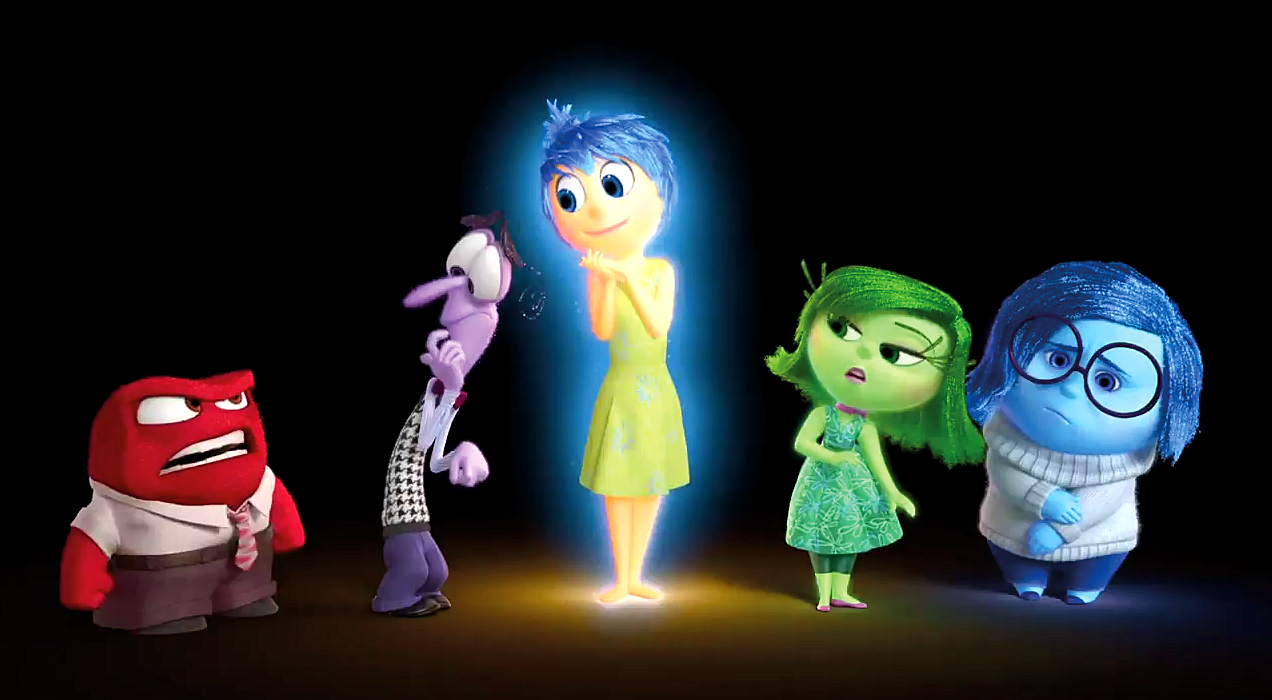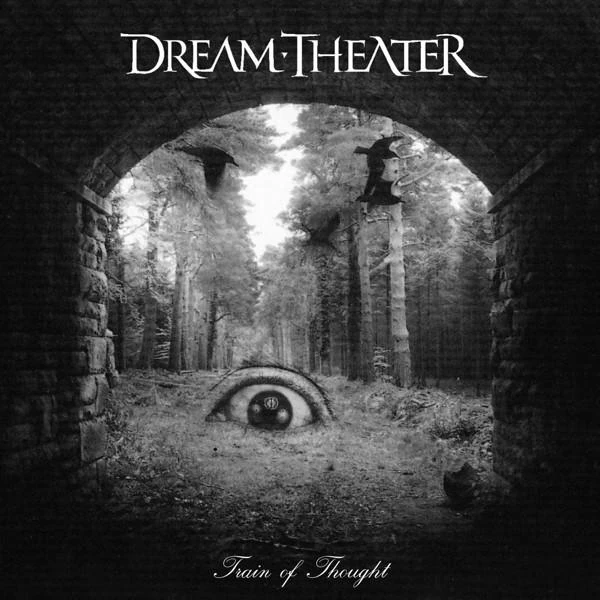So, I managed to collect enough money to go watch a movie in theaters. Without pop-corn, I told myself, as I had 10 bucks, not 20. ...Seriously, pop-corn is horribly expensive there, and don't get me started on 25 cents for every pack of ketchup powder- but I digress. Yesterday, I drove to the nearest mall that has a theater, I got my ticket for Inside Out, sat in the theater. watched the film...
...AND IT WAS MARVELOUS.
Inside Out is the story of Riley, an 11yo girl who's moving away from her Minnesota home to San Francisco with her two parents. The moving isn't done all that well; having to wait many days for the truck that contains all your stuff isn't exactly great news. Having to adapt to her new world, full of happy and not-so-happy surprises, the stress piles up on poor Riley. Comes a moment where it "breaks", in her, and from that point on it's like she can't enjoy life anymore...
 ...what she doesn't know is that it's all because of what happens in her head. Meet Joy, Sadness, Anger, Disgust and Fear. Joy is at the commands, most of the time, as she wants Riley to be happy above all else. However, all five of them are meant to stabilize a person's state of mind: Sadness is meant for the more tear-jerking emotions but also represents empathy; Anger is more than just tantrums, he is also useful when there are real reasons to get angry, like when an injustice happens; Disgust is kind of the mean girl of the group, but she's meant to protect Riley from poison, of the physical and social kinds; Finally, Fear means well and tries to secure Riley from danger, but his paranoia can be explained as him constantly getting hurt by pure bad luck.
...what she doesn't know is that it's all because of what happens in her head. Meet Joy, Sadness, Anger, Disgust and Fear. Joy is at the commands, most of the time, as she wants Riley to be happy above all else. However, all five of them are meant to stabilize a person's state of mind: Sadness is meant for the more tear-jerking emotions but also represents empathy; Anger is more than just tantrums, he is also useful when there are real reasons to get angry, like when an injustice happens; Disgust is kind of the mean girl of the group, but she's meant to protect Riley from poison, of the physical and social kinds; Finally, Fear means well and tries to secure Riley from danger, but his paranoia can be explained as him constantly getting hurt by pure bad luck.
The movie opens on Riley's early life; we see her as a baby (when the only two emotions she had were Joy and Sadness), and then we see her grow up in her family; she has great parents! Sure, the father is shown as kinda bumbling in one of the trailers, but that's only one scene in the entire film. (Oh, by the way, everyone else also has these anthropomorphic emotions in their heads.) Then we see Riley at 11, when she moves to San Francisco. Needless to say, things are quite rocky. However, in her head, we see Joy trying to keep everything, well, joyful. That is, until Sadness accidentally tampers with some of Riley's core memories, the ones that make up the most important elements of her personality: Family, Hockey, Silliness, Honesty and Friendship. (I went to a French screening of the film, so please don't whine if I got one of the names wrong.) I have to explain that in the brain-universes, memories are represented by spheres of the color that dominated when the memory happened. Most of it is short-term memory that will be discarded into the Memory Dump, an Abyss below the Brain Control center (where the emotions are). An abyss so deep, no memory can leave, and those memories are erased after some time. The important memories get stored in long-term memory, a gigantic maze of hallways that gets cleaned, every once in a while, to remove the memories that are no longer useful. This brain-universe also contains sections such as the abstract thoughts and the train of thought-
-Not quite like that; Not as dark, not as metal, not as musical. It also has Imagination Land (Thou shalt not make a South Park reference here!), the subconscious, and finally the Dream Productions, where the dreams are created when Riley sleeps.
Anyay, the plot kicks in when Joy tries to stop Sadness from interfering with Riley as she's being welcomed into her new class. And then trying to prevent Sadness from touching Riley's core memories and tainting them with her, well, sadness. Ensues a fight in which the five core memories are taken out of their pedestal accidentally, after which the long-term memory sendoff is activated, and then Joy and Sadness get caught into it with the five core memories, and get sent to the long-term memory maze. ...Leaving only Anger, Disgust and Fear at the controls. That won't lead to anything good.
The rest of the movie is Joy and Sadness trying to overcome their differences (and Joy learning the importance of sadness as more than just a negative emotion) as they venture across just about every portion of the brain-universe on their way back to the Brain Control. They do, however, get help from an unlikely character... (I'm not spoiling!) And during that time, the situation keeps getting worse as Anger, Disgust and Fear try, but are unsuccessful at restoring Riley's emotional state. Instead they tend to make things worse. ...Accidentally, of course, but still, whoa... Oh, but that's Pixar, you know it's gonna end well.
This film is touching, intense, and, as you may have guessed, incredibly emotional. It's got all kinds of great jokes you'd expect to pop up in discussions held by the personifications of emotions. The trip across the brain-universe (may I shorten that to Brainverse? Yes? Thanks.) is great and showcases, yet again, all the creativity at Pixar. There are so many little touches, and the story is knit in a way that almost every little detail becomes important in the end. What's that? A Checkov's Gun? No, more like an entire army of them! I like stories like that.
 Despite her being a control freak, you can't help but side with Joy and her contagious, uh, joy. In fact, all the characters are likable in their own way. Sadness, the poor blue gal, I just want to hug her, let her cry on my shoulder, give her a pat on the back and say "there, there". But when she smiles, it's the most adorable thing ever. Even more adorable than Joy. Anger is really, really funny to watch, and so is Fear. I was a little more apprehensive of Disgust, as she did mostly seem as the regular alpha b**** (I don't allow myself to swear in this review!), but thankfully her role is explained better and she ends up being a lot nicer than it seems at first glance. A lot of the dialog between the five, in Brain Control at least, sounds a lot like when you're arguing with yourself over what's the best thing to do. Same can be said for Riley and her parents; you really empathize with that young girl... though it kinda helps that you get to see wat's going on inside her head.
Despite her being a control freak, you can't help but side with Joy and her contagious, uh, joy. In fact, all the characters are likable in their own way. Sadness, the poor blue gal, I just want to hug her, let her cry on my shoulder, give her a pat on the back and say "there, there". But when she smiles, it's the most adorable thing ever. Even more adorable than Joy. Anger is really, really funny to watch, and so is Fear. I was a little more apprehensive of Disgust, as she did mostly seem as the regular alpha b**** (I don't allow myself to swear in this review!), but thankfully her role is explained better and she ends up being a lot nicer than it seems at first glance. A lot of the dialog between the five, in Brain Control at least, sounds a lot like when you're arguing with yourself over what's the best thing to do. Same can be said for Riley and her parents; you really empathize with that young girl... though it kinda helps that you get to see wat's going on inside her head.
Oh, but I also love the part of the story that takes place in reality. This must be the most realistic, uh, reality I've seen in an animated movie, ever. I mean, I get why; the fantastic part takes place in Riley's head. But I seriously admire the reality pictured here; it's amazing. I just can't give it justice, you have to witness it yourself.
There might be a slight pacing problem, though; I guess alternating between two universes, seeing what happens in Brainverse and the effects of it in reality, did make this movie really tricky on the pacing aspect. This also makes the story also quite complicated. Kids might not be able to follow. Along with this, there is quite a bit of discussion about the brain and its functions, with numerous terms kids won't understand, and even a few I didn't know. That's saying something. However, that last part is half-crtique, half-praise, as it just goes on to show that the writing team behind this movie did the research, and made sure their movie, despite the fantasy elements, was scientifically accurate to what we know of the brain. That's no small feat when your story is about two emotions getting lost in a brain-universe.
So, do I recommend it? Oh yes. This is going to be one of Pixar's classics, I can feel it. (See what I did there?) It would be in my Top 10 Pixar films, perhaps even the Top 5. It's a great, colorful, incredible trip through the brain that serves as an amazing adventure and as a learning tool. Seriously, go watch it. Whenever you can. Maybe not in theaters, maybe on DVD, in Blu-Ray, on Netflix, whatever, but watch it someday. You must.
I'm not revealing any more spoilers!



No comments:
Post a Comment